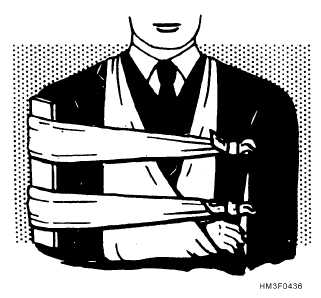Difference between revisions of "AY Honors/First aid/Upper arm splint/es"
(Created page with "</noinclude> Las señales de fractura de la parte superior del brazo incluyen dolor, sensibilidad, hinchazón y un movimiento tambaleante en el punto de fractura. Si la fractu...") |
(Created page with "; NOTA: El tratamiento de la fractura depende en parte de la ubicación de la ruptura.") |
||
| Line 3: | Line 3: | ||
Las señales de fractura de la parte superior del brazo incluyen dolor, sensibilidad, hinchazón y un movimiento tambaleante en el punto de fractura. Si la fractura está cerca del codo, es probable que el brazo esté recto, sin estar doblado en el codo. Si la fractura está abierta, detenga el sangrado y trate la herida antes de intentar de tratar la fractura. | Las señales de fractura de la parte superior del brazo incluyen dolor, sensibilidad, hinchazón y un movimiento tambaleante en el punto de fractura. Si la fractura está cerca del codo, es probable que el brazo esté recto, sin estar doblado en el codo. Si la fractura está abierta, detenga el sangrado y trate la herida antes de intentar de tratar la fractura. | ||
| − | ; | + | ; NOTA: El tratamiento de la fractura depende en parte de la ubicación de la ruptura. |
If the fracture is in the upper part of the arm near the shoulder, place a pad or folded towel in the armpit, bandage the arm securely to the body, and support the forearm in a narrow sling. | If the fracture is in the upper part of the arm near the shoulder, place a pad or folded towel in the armpit, bandage the arm securely to the body, and support the forearm in a narrow sling. | ||
Revision as of 18:46, 17 November 2014
Las señales de fractura de la parte superior del brazo incluyen dolor, sensibilidad, hinchazón y un movimiento tambaleante en el punto de fractura. Si la fractura está cerca del codo, es probable que el brazo esté recto, sin estar doblado en el codo. Si la fractura está abierta, detenga el sangrado y trate la herida antes de intentar de tratar la fractura.
- NOTA
- El tratamiento de la fractura depende en parte de la ubicación de la ruptura.
If the fracture is in the upper part of the arm near the shoulder, place a pad or folded towel in the armpit, bandage the arm securely to the body, and support the forearm in a narrow sling.
If the fracture is in the middle of the upper arm, you can use one well-padded splint on the outside of the arm. The splint should extend from the shoulder to the elbow. Fasten the splinted arm firmly to the body and support the forearm in a narrow sling, as illustrated.
Another way of treating a fracture in the middle of the upper arm is to fasten two wide splints (or four narrow ones) about the arm and then support the forearm in a narrow sling. If you use a splint between the arm and the body, be very careful that it does not extend too far up into the armpit; a splint in this position can cause a dangerous compression of the blood vessels and nerves and may be extremely painful to the victim. If the fracture is at or near the elbow, the arm may be either bent or straight. No matter in what position you find the arm, DO NOT ATTEMPT TO STRAIGHTEN IT OR MOVE IT IN ANY WAY. Splint the arm as carefully as possible in the position in which you find it. This will prevent further nerve and blood vessel damage. The only exception to this is if there is no pulse on the other side of the fracture (relative to the heart), in which case gentle traction is applied and then the arm is splinted. Treat the victim for shock and get him under the care of a medical professional as soon as possible.

